Serviços Personalizados
Artigo
Indicadores
Links relacionados
-
 Citado por Google
Citado por Google -
 Similares em Google
Similares em Google
Compartilhar
Journal of the South African Institution of Civil Engineering
versão On-line ISSN 2309-8775
versão impressa ISSN 1021-2019
J. S. Afr. Inst. Civ. Eng. vol.52 no.2 Midrand Out. 2010
TECHNICAL PAPER
The status of talent management in the South African consulting civil engineering industry in 2008: A survey
P Oosthuizen; H Nienaber
ABSTRACT
Talent management, an integrated system of recruitment, development and retention of the required human capital at all organisational levels, is at the forefront of business agendas. Given the skills shortage in South Africa, talent management is expected to remain a business imperative especially in the science, engineering and technology arena. The importance of talent management stems from its role in achieving competitive advantage in order to realise the strategy of the organisation. In this paper the perceptions of people responsible for talent management in their respective organisations are presented to determine the status of talent management in the South African consulting civil engineering industry in 2008. The survey found that most respondents (94%) thought talent management was a priority but only 57% of them had some talent management initiative in place. The primary concern (55% of respondents) was to create a deep reservoir of successors at all hierarchical levels of the organisation. Inability to do so threatens not only the continuity of the organisation per se, but also the wealth-creating capacity of the country as a whole, since civil engineers play a primary role in creating and maintaining infrastructure.
Keywords: talent management, consulting civil engineering industry, South Africa, skills shortage, competitive advantage
INTRODUCTION
The past decade has seen a multitude of publications on "the war for talent" resulting from a worldwide skills shortage (Axelrod et al 2001). In South Africa the skills shortage, especially in the science, engineering and technology fields, has received heightened attention. The South African government has realised the importance of engineering skills and has embarked on a number of initiatives to address the situation. One such initiative was the creation of the Joint Initiative for Priority Skills Acquisition (JIPSA), which identified five high-priority skills, of which engineering was one. There is a shortage of engineering skills in South Africa (Mail & Guardian Online 2007a, b), including civil engineers - particularly experienced, mid-career (between 35 and 50 years old) professionals who are required to execute major projects and to transfer knowledge to young staff (Lawless 2005). This shortage of engineering skills in South Africa is exacerbated by a number of factors, including the mobility of engineers between economic sectors and countries, as well as the low number of qualified engineers produced (Steyn & Daniels 2003). The engineering skills shortage emphasises the importance of talent management in the engineering industry in South Africa.
In the information age, knowledge workers such as engineers are necessary to sustain the competitive advantage of organisations and nations. For the organisation, talent at all hierarchical levels and across all occupations within the organisation forms one of the building blocks of an organisation's competitive advantage (Bersin 2008, Boxall 1998, Grant 1996, Heinen & O'Neill 2004, Peteraf 1993, Truss & Gratton 1994). For the nation, the availability of engineers is a useful measure of a country's potential for innovation and wealth creation. Infrastructure, in particular, is seen as a major determinant of the state of the economy and the living standards of a country's people. Civil engineers play a central role in the design, construction and smooth functioning of infrastructure such as roads, railways, water supply, sanitation and buildings such as schools, hospitals and housing. Infrastructure in South Africa is currently undergoing major upgrading, which demands that proper attention be given to talent management in the consulting civil engineering industry, in particular.
Research into talent management is relatively scarce and in 2006 such research was conducted by the Society for Human Resource Management (SHRM) (Fegley 2006). The results of that survey showed that, although talent management was recognised as an important initiative, it was merely receiving lip service from respondents. Since 2008, further studies into talent management have been undertaken with similar results. Obtaining and retaining top talent is cited as one of the biggest challenges and highest priorities in business (Harvey 2009, Linne 2009). However, talent management strategies remain ineffective (Harvey 2009, Nancherla 2009). At times of economic uncertainty, talent continues to be a corporate preoccupation as CEOs want to be sure that they have the right talent to lead them through the downturn to the eventual recovery (Harvey 2009). It is especially the retention of the right employees that will ensure the delivery of a long-term competitive advantage that matters (Cook & Macaulay 2009).
The study reported in this paper reflects the perceptions of people responsible for talent management in their respective organisations with regard to identifying the status of talent management (i.e. recruitment, development and retention of required staff) in the civil engineering industry in South Africa in 2008. As far as can be ascertained, no previous research has been done in this area and, as such, it fills a gap - specifically by suggesting an approach to integrating existing elements of talent management to benefit organisations, industry and the country optimally.
THEORETICAL FRAMEWORK
People's importance in organisational performance has been emphasised since the earliest writings on management (for example, Owen 1825). But the concept of talent management is relatively new and not clearly defined, given the complex undertaking embraced by the term (Chartered Institute of Personnel and Development 2006a). The literature suggests a wide range of definitions for talent management, which do not correspond entirely as some are more comprehensive than others (for example, Creelman 2004, Heinen & O'Neill 2004, Chartered Institute of Personnel and Development 2006a, Lewis & Heckman 2006, Lockwood 2006, Rowan 2008). The focus of the talent management effort also differs: in some cases the emphasis is on top management (Kesbey 2008), while others attend to all echelons (Bersin 2008, Harvey 2009). In its broadest sense, talent management may be viewed as "the implementation of integrated strategies and systems to increase workplace productivity by developing improved processes of attracting, developing, retaining and utilising people with the required skills and aptitudes to meet current and future business needs" (Lockwood 2006). This definition seems to cover the entire human resource function. Typical talent management involves an integrated system of recruitment, development and retention of the required human capital, at all organisational levels, which is necessary to achieve competitive advantage in order to realise the objectives of the organisation (Bersin 2008, Creelman 2004, Cunningham 2007, Harvey 2009, Heinen & O'Neill 2004, Rowan 2008, Scappatura 2009). The definition of talent management signifies its importance in terms of business results (performance), now and in the future, which are intertwined with the more explicitly stated competitive advantage.
Competitive advantage explains and predicts why some organisations are able to attain and sustain performance that earns higher returns (Carpenter & Sanders 2009, David 2009, Hough et al 2008, Ireland et al 2009, Pearce & Robinson 2009). In its simplest form, competitive advantage means that the organisation makes it easier for customers to do business with the organisation than its competitors, based on the value offered to the customers (Kotler & Armstrong 2000). In essence, competitive advantage consists of three dimensions, namely (1) the arena in which the organisation chooses to compete, (2) the value offered to customers, and (3) access to assets, resources, skills, processes and systems (capabilities) to offer value to customers in the chosen arena (Nienaber, Cant & Strydom 2002). The core of competitive advantage is management's ability to deploy its current unique bundles of resources and capabilities in a way that maximises value, while it develops the resources and capabilities required for the future (Grant 1996, Helfat & Peteraf 2003, Peteraf 1993). Of all the resources at the firm's disposal, knowledge is the most important. Hence the statement made earlier that talent at all hierarchical levels and across all occupations within the organisation forms one of the building blocks of an organisation's competitive advantage (Bersin 2008, Boxall 1998, Cunningham 2007, Grant 1996, Heinen & O'Neill 2004, Helfat & Peteraf 2003, Peteraf 1993, Truss & Gratton 1994). To capture the advantage of knowledge within many different individuals employed by the firm, the firm needs to integrate and utilise its specialist knowledge - which may be context-specific - in many ways. A coordinating mechanism to realise this advantage may be found in an integrated talent management system, which is clearly connected with the strategy of the business and provides the opportunity to attain and sustain competitive advantage.
Performance of the functions of talent management is hampered by a variety of factors, ranging from its application in business to the worldwide shortage of skills. It stands to reason that the shortage of skills adversely affects the creation of a deep reservoir of skills. Furthermore, the civil consulting engineering industry in South Africa may experience increased performance pressures. This may be due to engineering skills being so mobile and the possibility that the current recession will result in talent management being put on the back burner in favour of more pressing issues. Care should therefore be taken to ensure that the right talent is retained to ensure bench strength for sustained performance.
In the talent management study conducted by the Society for Human Resource Management (SHRM) (Fegley 2006), a questionnaire was sent to a random sample (2 622) of its 200 000 members who were active in different sectors of the US economy. A total of 384 companies (13%) responded to the questionnaires. Fifty-three per cent of respondents indicated that they had a talent management initiative in place. This response contradicts the response of 76% of participants who indicated that talent management was a top priority in their company. Since then, other studies have been undertaken with similar results, namely that talent management is a priority, but talent management strategies remain ineffective (Harvey 2009, Linne 2009, Nancherla 2009).
Talent management is an important part of the management of the organisation, especially in gaining a competitive advantage to ensure organisational performance. The changing competitive landscape and lack of availability of especially engineering skills make finding and retaining talent a top priority for all organisations.
RESEARCH DESIGN AND METHODOLOGY
The enquiry into talent management is situated within a positivist research philosophy, with its emphasis on describing a social reality. In our study, we attempted to describe the perceptions of the status of talent management in the consulting civil engineering industry in South Africa in 2008. The problem was studied by way of a survey, utilising a web-based questionnaire addressed to selected members of Consulting Engineers South Africa (CESA) to collect empirical evidence. A survey among CESA members was deemed appropriate because more consulting engineers could be reached this way, making it possible to gather valuable information about the problem studied.
At the same time, this design was more economical than individual interviews.
This study replicated that of the SHRM (Fegley 2006). Replication is important in scientific knowledge creation to ensure empirical generalisation (Babbie 2007, Berthon et al 2002, Hubbard & Vetter 1996, Hubbard et al 1998, Hunter 2001, Neuman 2006). The research question was: "What was the status of talent management in the consulting civil engineering industry in South Africa in 2008, as perceived by staff involved in talent management?" The central thesis of the study was that talent management was recognised as a business imperative, but did not receive sufficient attention, given its importance.
The definition of talent management as proposed by the SHRM (Fegley 2006), namely "the implementation of integrated strategies and systems to increase workplace productivity by developing improved processes of attracting, developing, retaining and utilising people with the required skills and aptitudes to meet current and future business needs", served as the reference definition for this enquiry. The clarification of concepts took care of construct validity, as the people completing the questionnaire could agree or disagree with the definition of the construct studied (Perry 2001).
The data were collected by way of a webbased questionnaire, consisting of closed-end questions, which were statistically analysed and interpreted. The closed-end questions ensured classification into standardised categories which facilitated comparison. The questionnaire was used with the permission of the SHRM, the owners of the questionnaire. It covered: demographics (questions 18-22); whether the firm had talent management initiatives in place (question 1); whether such initiatives were important or not (question 2); the amount of budget available for the different elements of talent management now and in the future (questions 10-16); current talent management practices (questions 7 and 17); areas in talent management practices that could be improved (question 3); and who is responsible for talent management initiatives (questions 4-6). Since the questionnaire had been used previously and had thus been tested, it was not necessary to pre-test it again for purposes of this enquiry.
The research population consisted of 282 consulting civil engineering firms on the CESA database with more than five full-time employees. A sample consisting of 30 firms was selected on the basis of a probability sample - specifically, a stratified random sample used to select a proportionate representative sample from each strata - consisting of large and small firms. "Large" firms employed more than 50 full-time employees, while "small" firms employed more than five but fewer than 50 full-time employees. Field (2005) suggests that a sample of 28 is sufficient to detect large effects, although not medium and small effects. As such, the sample size is considered sufficient for the purposes of this study.
The unit of analysis was thus the organisations studied, while the unit of observation was the person completing the questionnaire (Babbie 2007, Perry 2001). The main limitation of this study could be that the views of the respondents may not represent the views of the organisation, thereby compromising validity. Reliability was ensured by using a formalised, structured process which, if followed by other researchers, should achieve the same results. The structured process included the use of a standardised questionnaire with clear instructions, administration in a certain way and data processing that ensured replication.
It should be noted that this study complied with ethical requirements in that informed consent was obtained from participants and they were promised that the information submitted would be treated confidentially.
RESULTS AND DISCUSSION
All 30 companies invited to respond did so. However, one did not respond to all the questions. The 29 complete responses are in keeping with the guideline of 28 proposed by Field (2005) and, as such, are deemed to be sufficient for the purposes of this study. The position of the respondents in their respective firms is shown in Table 1.

Table 1 shows that the respondents held various positions in their respective firms, with the majority (31%) being CEOs/directors/managing directors, followed by engineering professionals (21%), branch/administrative managers (17%), HR managers (14%), HR office managers (10%) and financial managers (7%). Most respondents are therefore "line managers" who are directly involved in the core business of the organisation, i.e. consulting civil engineering.
Table 2 summarises the responses regarding who was primarily charged with the responsibility for talent management initiatives (i.e. recruitment, development and retention of required employees) within the respondents' respective organisations.

Table 2 shows that most respondents indicated that the department head was responsible for talent management initiatives, followed by HR staff in terms of recruitment and then the employee's supervisor. However, the supervisor played a more important role in development and retention than HR. Given that talent management is a building block of competitive advantage, it stands to reason that the departmental head and supervisor are responsible for talent management. This suggests the importance of line managers in the performance of the firm and points to the integration of talent management initiatives with the strategy of the firm. On this basis one can assume that the respondents (as reflected in Table 1) were indeed involved in talent management and can be accepted as relevant to the study. Furthermore, the response that line managers are primarily responsible for talent management is congruent with the views of Bersin (2008), Cunningham (2007), Fegley (2006), Harvey (2009) and Scappatura (2009).
Figure 1 illustrates the responses to the question of whether talent management is considered a top priority in the respondents' respective firms. The respondents did not question the importance of talent management. This response is congruent with that of Fegley (2006), Harvey (2009), Linne (2009) and Nancherla (2009).

Figure 2 illustrates the responses to the specific talent management initiatives (i.e. recruitment, development and retention) that are in place in the respective organisations. It is clear that 43% of the respondents do not have specific talent management initiatives in place. This is at odds with the previous response, showing that talent management is a top priority. Of the 57% of respondents that have talent management initiatives in place, the initiative most often cited was identification and retention of talent, followed by recruitment; the least cited option was formal development plans for employees. This response is indicative of the importance of talent management initiatives in the firms studied and corresponds to the findings of Fegley (2006) and Nancherla (2009).
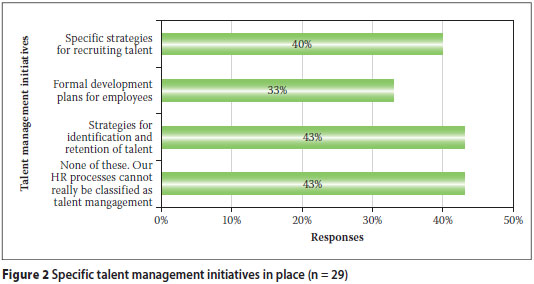
Table 3 provides a comparison of talent management initiatives between large and small-to-medium firms. Large firms have slightly more talent management initiatives in place than do smaller firms. However, the difference between small and large firms is not statistically significant, implying that firms of both sizes are equally likely to have such initiatives in place (the chi-square value is 0,293 and this is not significant at the 95% level with p = 0,435).
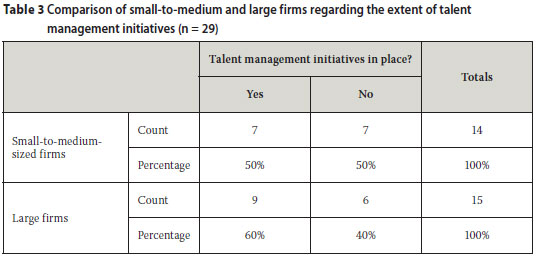
Talent management initiatives can be implemented and sustained only if the necessary budget is available. Figure 3 depicts the percentage of firms that have formal budgets in place for the three typical talent management initiatives. Most of the respondents indicated that they had formal budgets in place for the three talent management initiatives. This observation is congruent with their response that talent management is a top priority in their firms. The majority of respondents indicated that they had a budget for development; the next greatest percentage had a budget for retention; and the smallest percentage indicated a budget for recruitment. The budget for development of employees is encouraging as development of employees constitutes a part of competitive advantage. However, this response seems at odds with the number of responding firms that actually indicated that they had some form of talent management initiative in place, with identification and retention being the most important ones, as reflected in Figure 2.
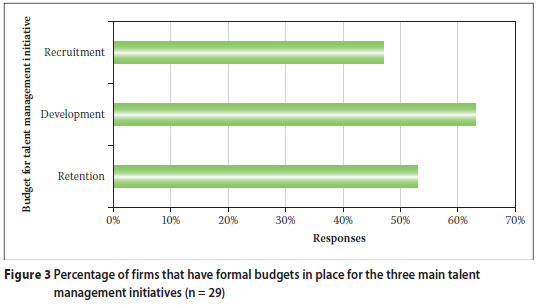
Responses to the expected change in the budgets for talent management initiatives are presented in Figure 4. Most respondents anticipated an increase in the budgets for the three functions, some substantially and others only marginally. Those respondents who foresaw an increase in the budget for talent management initiatives seemed to be capitalising on the current economic conditions (2008) to ensure bench strength. A relatively small number of respondents foresaw no change in these budgets. This is consistent with typical practices during an economic recession - other more pressing issues receive attention, while talent management is placed on the back burner. It is nevertheless encouraging to note that, at the time of the study, these organisations did not intend cutting budgets; they were thus preparing for the long-term competitiveness of their organisations.
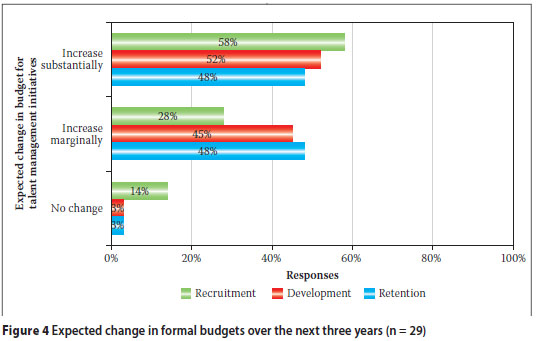
Respondents had the opportunity to select the three top areas in the organisation that need to improve to ensure the success of their talent management initiatives. These responses are shown in Figure 5. A variety of issues were raised as concerns, but the three top issues highlighted by the respondents are:
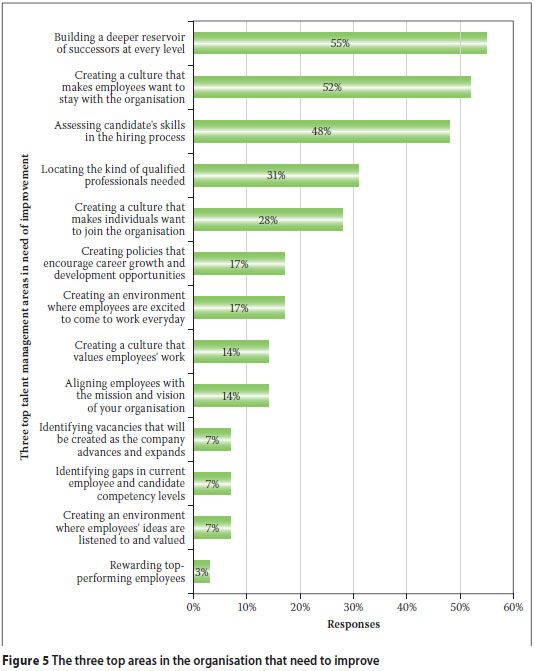
Building a deeper reservoir of successors at every level
Creating a culture that makes employees want to stay with the organisation
Assessing a candidate's skills during the hiring process.
These three areas of improvement are in line with the current skills shortage and point to the importance of retaining the right skills. This observation is consistent with that of Cunningham (2007) and Nancherla (2009).
Effective talent management initiatives take into account a number of organisational practices and strategies. The respondents' ratings of these practices in their organisations are shown in Figure 6. Generally, these practices and strategies were rated positively. The category "creates an environment where employees are excited to come to work every day", as well as "aligns employees with the vision and mission of the organisation", "creates a culture that values employees' work" and "creates an environment where employees' ideas are listened to and valued" were rated less positively. All of these may adversely affect talent management.
These practices and strategies were also compared for the two groupings of the firms' sizes by means of the Mann-Whitney test. Areas that differed significantly are presented in Table 4. The smaller organisations appeared to have been more successful in these practices and strategies than the larger organisations. Some organisational practices influencing the attraction and retention of staff seemed to hamper talent management in the organisations studied.
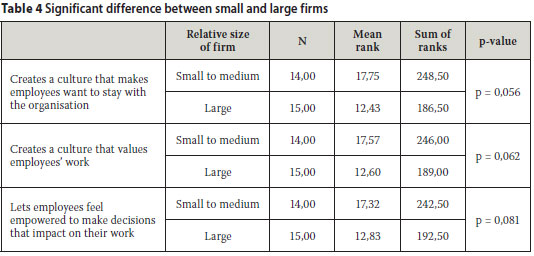
CONCLUSIONS
This paper discussed the perceptions of the status of talent management in South African consulting civil engineering organisations in 2008. Talent management aims at recruiting, developing and retaining the required skills and aptitudes at all hierarchical levels of the organisation. As such, it is an important initiative in achieving and sustaining the competitive advantage of an organisation to ensure good business results. To succeed, talent management should be integrated with the overall strategy of the organisation. Hence line managers such as department heads and direct supervisors are important role players in talent management.
This study found that line managers were, to differing degrees, involved in the talent management initiatives of recruitment, development and retention of talent. Department heads were predominantly involved in all three of these initiatives. This indicates that these organisations generally endeavour to align their talent management practices with the overall organisational strategy.
The majority of respondents to this survey did not question the importance of talent management. However, only a portion of them indicated that their organisations had a talent management initiative in place. Given the three areas in which talent management initiatives need to improve to ensure success, namely building a deeper reservoir of successors at every level, creating a culture that makes employees want to stay with the organisation and assessing a candidate's skills during the hiring process, it seems as if the current talent management initiatives are not very effective. One of the reasons for this state of affairs may be the skills shortage in the area of science, engineering and technology, which falls outside the scope of management control. Another reason for the ineffectiveness of the initiatives is that little attention is being given to "creating a culture that would make employees want to stay". This was especially true for the large organisations in which talent management practices and strategies were less skilful in achieving a positive impact than smaller organisations.
The majority of respondents indicated that they had a budget available for talent management initiatives, but development of employees had a larger budget allocation than recruitment and retention. This is probably because development of employees can be used as a powerful retention aid.
The findings supported the thesis of the study, namely that although talent management is recognised as a business imperative, it does not receive sufficient attention, given its importance. The changing competitive landscape, especially the lack of science, engineering and technology skills in South Africa and the tendency of engineers to move towards more attractive sectors and countries, necessitates attention to talent management. It is our opinion that the future competitiveness of South African consulting civil engineering firms may be in jeopardy if their talent management initiatives do not pay off.
It is recommended that these firms leverage their talent management initiatives and improve their formal practices and strategies in connection with talent management to enhance its effectiveness.
REFERENCES
Axelrod, E L, Handfield-Jones, H & Welsh, T A 2001. War for talent, Part two. The McKinsey Quarterly, Spring: 9-12. [ Links ]
Babbie, E 2007. Practice of social research. New York: Wadsworth. [ Links ]
Berthon, P, Pitt, L, Ewing, M & Carr, C L 2002. Potential research pace in MIS: A framework for replication, extension and generation. Information Systems Research, 13(4): 416-427. [ Links ]
Bersin, J 2008. The business impact of talent management. Banking Strategies, 84(5): 6. [ Links ]
Boxall, P 1998. Achieving competitive advantage through human resource strategy: Towards a theory of industry dynamics. Human Resource Management Review, 8(3): 265-288. [ Links ]
Carpenter, M A & Sanders, G 2009. Strategic management: A dynamic perspective. Upper Saddle River: Pearson International. [ Links ]
Chartered Institute of Personnel and Development. 2006a. Talent management: Understanding the dimensions.http://www.cipd.co.uk [ Links ]
Chartered Institute of Personnel and Development. 2006b. Reflections on talent management.http://www.cipd.co.uk [ Links ]
Cook, S & Macauley, S 2009. Talent management: Key questions for learning and development. Training Journal, July: 37-41. [ Links ]
Creelman, D 2004. Return on investment in talent management: Measures you can put to work right now. Washington D C: Human Capital Institute. [ Links ]
Cunningham, I 2007. Talent management: Making it real. Development and Learning in Organizations, 21(2): 4. [ Links ]
David, F R 2009. Strategic management: Concepts and cases. Upper Saddle River: Pearson International. [ Links ]
Fegley, S 2006. 2006 Talent management survey report. Society for Human Resource Management. http://www.shrm.org/research [ Links ]
Field, A 2005. Discovering statistics using SPSS. Thousand Oaks: Sage. [ Links ]
Grant, R M 1996. Toward a knowledge-based theory of the firm. Strategic Management Journal, 17 (Winter Special Issue): 109-122. [ Links ]
Harvey, D 2009. Talent strategy is vital. Personnel Today, June 23: 13. [ Links ]
Heinen, J S & O'Neill, C 2004. Managing talent to maximise performance. Employment Relations Today, 31(2): 67. [ Links ]
Helfat, C E & Peteraf, M A 2003. The dynamic resources-based view: Capability lifecycles. Strategic Management Journal, 24(10): 997. [ Links ]
Hough, J, Thompson, A A Jr, Strickland III, A J & Gable, J E 2008. Strategic management: Concepts and case,. 13th ed. Boston: McGraw Hill. [ Links ]
Hubbert, R & Vetter, D E 1996. An empirical comparison of published replication research in accounting, economics, finance, management and marketing. Journal of Business Research, 35: 153-164. [ Links ]
Hubbard, R, Vetter, D E & Little, E 1998. Replication in strategic management: Scientific testing for validity, generalizability and usefulness. Strategic Management Journal, 19(3): 243-254. [ Links ]
Hunter, J E 2001. The desperate need for replications. Journal of Consumer Research, 28(1): 149-158. [ Links ]
Ireland, R D, Hoskisson, R E & Hitt, M A. 2009. The management of strategy: Concepts and cases. Mason: Cengage Learning. [ Links ]
Kesbey, D 2008. Talent management. Training Journal, December: 34. [ Links ]
Kotler, P & Armstrong, G 2000. Principles of marketing. Upper Saddle River: Prentice-Hall. [ Links ]
Lawless, A 2005. Numbers and needs: Addressing imbalances in the civil engineering profession. Halfway House: South African Institution of Civil Engineering. [ Links ]
Lewis, R E & Heckman, R J 2006. Talent management: A critical review. Human Resource Management Review, 16: 139-154. [ Links ]
Linne, L 2009. Obtaining and retaining the best talent. Rough Notes, 152(6): 32-34. [ Links ]
Lockwood, N R 2006. Talent management: Driver for organizational success. HR Magazine, 51(6). [ Links ]
Mail & Guardian Online. 2007a. Study highlights skills shortage in SA. http://www.mg.co.za/articlePage.aspx?articleid=310563&area=/breaking_news/breaking_news__business [ Links ]
Mail & Guardian Online. 2007b. 'More needs to be done' to plug skills gap. http://www.mg.co.za/articlePage.aspx?articleid=327353&area=/breaking_news/breaking_news__business [ Links ]
Nancherla, A 2009. Prioritizing the people. Training & Development, 63(4): 22. [ Links ]
Neuman, W L 2006. Social research methods: Qualitative and quantitative approaches, 6th ed. Boston: Pearson International. [ Links ]
Nienaber, H, Cant, M C & Strydom, J W 2002. An exploratory investigation into the application of market strategies by selected JSE-listed companies in the food sector in the period 1996-1999. Southern African Business Review, 6(1): 24-30. [ Links ]
Owen, R 1825. An address to the superintendents of manufacturing. In: Merrill, H F (Ed) 1970, Classics in management, New York: American Management Association, pp 11-18. [ Links ]
Pearce, J A & Robinson, R B, Jr 2009. Formulation, implementation and control of competitive strategy, 11th ed. New York: McGraw-Hill Irwin. [ Links ]
Perry, C 2001. Case research in marketing. The Marketing Review, 1: 303-323. [ Links ]
Peteraf, M A 1993. The cornerstones of competitive advantage: a resource-based view. Strategic Management Journal, 14(3): 179-191. [ Links ]
Rowan, L 2008. Market analysis. Worldwide and U.S.talent acquisition and staffing services 20082012 forecast. Framington: International Data Corporation (IDC). [ Links ]
Scappatura, A 2009. Talent management needs to adapt, evolve. Canadian HR Reporter, 22(12): 8. [ Links ]
Steyn, G & Daniels, C 2003. Engineers and technicians. HRD Review, Chapter 24, Pretoria: Human Sciences Research Council. [ Links ]
Truss, C & Gratton, L 1994. Strategic human resource management: A conceptual approach. International Journal of Human Resource Management, 5(3): 663-686. [ Links ]
 Contact details:
Contact details:
Southern Geotechnical Engineering
PO Box 1687 Brooklyn Square
0075 South Africa
Tel: 27 12 430 2081
e-Mail: pieter@sgeng.co.za
Contact details:
UNISA Department of Business Management
PO Box 392 UNISA
0003 South Africa
e-Mail: nienah@unisa.ac.za
 | PIETER OOSTHUIZEN is a registered professional engineer. He has more than 15 years of engineering experience relating to the field of geotechnical engineering. Pieter obtained his MEng (Civil Engineering) degree from the then Rand Afrikaans University in 1994 and completed an MBA at the University of Pretoria in 2008. In 2007 Pieter started his own consulting engineering company, Southern Geotechnical Engineering. |
 | DR HESTER NIENABER lectures in strategic management at the University of South Africa (UNISA). She has 25 years' experience, in both the public and private sectors, and her lecturing experience spans almost a decade. Her research interests include strategy, performance, competitive advantage and related fields, in which she publishes, presents papers (nationally and internationally), consults and mentors postgraduate students. |














